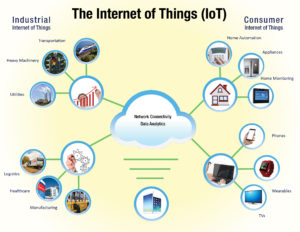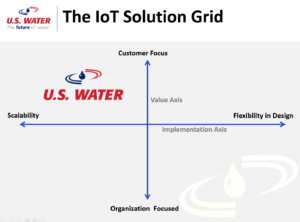There is a lot of talk in the technology market about the Internet of Things (IoT). But, what does that mean and how does it affect water treatment technologies?
As people living in a modern world, technology is the center of nearly everything we do. Human nature constantly drives us to improve our “things” through newly engineered technology. The Internet of Things (IoT) is about using technology to make these “things” communicate to us in different and valuable ways utilizing the internet. Simply put, the IoT is about making some piece of hardware (or thing) communicate to the internet to provide additional value to people. With the advancements in today's water treatment technology, facilities should work with their water treatment partners to determine how the IoT technology could positively impact their organization.
 A natural separation in the technology market has begun, splitting the consumer internet of things (home security systems, entertainment or automobiles) and the industrial internet of things (logistics, heavy machinery, industrial equipment). As stated in a 2011 Cisco IBSG white paper, the number of connected things officially passed the estimated world population at 8 billion in 2008. By 2020, companies such as Cisco are estimated to have approximately 50 billion things to be connected. Other companies have estimated even higher figures. Regardless of the source, the number is increasing at an exponential pace.
A natural separation in the technology market has begun, splitting the consumer internet of things (home security systems, entertainment or automobiles) and the industrial internet of things (logistics, heavy machinery, industrial equipment). As stated in a 2011 Cisco IBSG white paper, the number of connected things officially passed the estimated world population at 8 billion in 2008. By 2020, companies such as Cisco are estimated to have approximately 50 billion things to be connected. Other companies have estimated even higher figures. Regardless of the source, the number is increasing at an exponential pace.
Technology has been commonplace for water treatment suppliers and their customers for decades; offering remote notifications, monitoring, and even control of various water treatment related equipment. While the water treatment industry has generally done a good job of keeping up with technology, the advancements in communications related technologies have improved quickly based on the growth in the IoT. As U.S. Water saw the emergence of the IoT in the early 2010's, we began building systems capable of handling the mass amounts of information that would be collected from equipment.
The Benefits of the Industrial IoT
Many companies are benefiting from the IoT today. A company may be utilizing IoT to increase logistics and supply chain efficiencies by tracking its fleet of delivery vehicles. Vending machine companies have started adding credit card scanners to their machines to improve their customer service with payment flexibility, as well as track assets to improve the inventory process and decrease the risk to equipment. On the manufacturing production floor, companies are implementing systems to integrate the logs used by quality, production and the supply chain teams to manage the overall cost of operation.
There are various ways for consumers to embrace the IoT. It's important for companies to understand what they want to get from investments in an IoT solution. Take figure 1 for example. Investment is very significant (and perhaps cost prohibitive) for a solution that provides scalability, flexibility, speed to market, and both an internal and external focus. However, if a company can identify what kind of solution they want to bring to market, the execution becomes very realistic. U.S. Water's IoT solution was decidedly developed with a customer focus. When we initially began building the solution, the emphasis was on speed to market due to the availability of emerging IoT technologies at the time. We have recently changed our focus to a much more scalable operation.
Let's take a very simple application to further paint the spectrum of the IoT. Nearly every water treatment application involves the feed of some type of chemical. A water treatment supplier with an organization focus may only be concerned when the tank level gets to a low “reorder” point; and their sensing equipment will likely only be capable of that.
However, depending on the chemical being fed, problems can develop when the chemical is not fed or not fed at the proper rates. A pump might be air-locked or unplugged, or it may be stuck on due to an improper controller reading. The tank may be leaking or the temperature may have dropped to below the freezing point of the chemical being fed. The water chemistry may have changed and the feed rate of the chemical may be too high or low. All of these problems and more can be identified when the proper sensing equipment is utilized and integrated into the entire IoT solution.
U.S. Water's solution to tank level monitoring examines far more than just reporting a specific tank level for reordering purposes. As levels are reported to U.S. Water's cloud-based software, the reported level reading is examined in relation to itself for rate of change in the chemical level. High or low usages are detected and the proper individuals are notified. The chemical tank level along with the rate of change information is also examined with a myriad of other parameters to identify both acute and chronically developing problems; some which were discussed above.
As you can see, it does not take much to complicate something as simple as tank level monitoring. However, there is significant value unlocked by doing so. U.S. Water takes this approach to everything we monitor which creates a matrix of dependencies, calculations, latencies, and derivations on each data point. This allows us to provide our customers with valuable notifications that contain actionable information along with visualizations to keep you engaged and up to date on the performance of your assets.
U.S. Water IoT Solution Connectivity
- U.S. Water's TowerAssure™ Control Systems
- U.S. Water's SMART Care™ for Membranes Program
- Boiler/Cooling Water Treatment Controllers
- 3rd Party Data Historians, PLC's, and DCS/SCADA Systems
- Added sensors for monitoring purposes only

